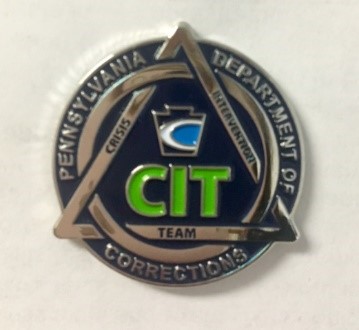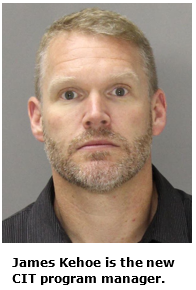 Since implementing Crisis Intervention Team (CIT) training in 2012, the DOC has trained nearly 2,000 employees!
Since implementing Crisis Intervention Team (CIT) training in 2012, the DOC has trained nearly 2,000 employees!
CIT training focuses on the challenges corrections employees face when dealing with inmates experiencing mental health crisis that goes well beyond what the untrained non-professional could be expected to know or understand. The CIT training program helps staff better understand the challenges many inmates face and how to effectively resolve tense, dynamic and evolving crisis situations.
The CIT training program is part of a system-wide initiative to place inmates' mental health at the forefront of treatment during incarceration. Moreover, CIT is about maximizing safety for both staff and inmates. By providing this education to our staff, we reduce the likelihood of use of force situations.
The CIT training program is an effective crisis response training for DOC employees who encounter inmates experiencing crisis. In addition to an overview of mental illness – medical and other risk factors in the inmate population – this training provides corrections staff with specific skills and strategies to recognize and de-escalate inmates in crisis.
The first CIT program was developed in Memphis in 1988 and provided training in mental disorders and response techniques to law enforcement officers. CIT is a crisis response and diversion strategy for justice involved persons with mental health problems in which specialized corrections and law enforcement officers respond to persons with possible mental health problems. At the Training Academy, those serving as CIT training program manager hold the position on a rotating basis. Staff serving in this role have completed the training program, are involved in championing the CIT implementation and response at a facility, and have a commitment to continue a high standard of excellence in the training.
As described by SCI Somerset Unit Manager Jennifer McClelland in 2017, "Crisis Intervention is a technique used to offer immediate, short-term help to an individual experiencing a crisis (i.e., an event that causes emotional, mental, physical, or behavioral distress). It involves resolving a crisis by recognizing the signs and symptoms of mental illness, using proper de-escalation techniques and utilizing a multidisciplinary approach to help the individual resolve his or her issues. Crisis Intervention is a preventative approach to behavior management, which can help decrease assaultive behavior and use of force incidents. It is a valuable tool for all of us that work in corrections, because it can increase both staff and offender safety."
Since 2012, the DOC has had several CIT training program managers: Superintendent Marirosa Lamas, SCI Muncy Lieutenant Virgil Meyer and SCI Frackville Unit Manager Rhonda Tomcavage. The current program manager is James Kehoe.
 Kehoe began his corrections career in October 2000 as a COT at SCI Mahanoy. After working as a CO1 for five years, he promoted to sergeant in 2005. During his 10 years as sergeant, Kehoe went back to night school to meet the qualifications for corrections counselor. In 2015 he was hired as a corrections counselor 1, and he promoted to a corrections counselor 2 after six months.
Kehoe began his corrections career in October 2000 as a COT at SCI Mahanoy. After working as a CO1 for five years, he promoted to sergeant in 2005. During his 10 years as sergeant, Kehoe went back to night school to meet the qualifications for corrections counselor. In 2015 he was hired as a corrections counselor 1, and he promoted to a corrections counselor 2 after six months.
Kehoe began serving as the adjunct instructor for CIT in 2017 and was named CIT program manager in July 2018.
"I am extremely passionate about the program," Kehoe said.
Kehoe caught the attention of Secretary John Wetzel when he learned of a situation involving Kehoe at SCI Mahanoy in 2015.
Back then, Kehoe was a sergeant in what was then the facility's special needs unit.
"One day during morning mainline, an inmate came out of his first-floor cell and walked up to the second level, or tier, and proceeded to stand on the railing and lit a cigarette. He was threatening to jump," Kehoe said.
Everyone immediately noticed and took action, because this inmate previously had successfully jumped in a similar situation at another facility, resulting in serious injury.
Kehoe said he was called over to the area and began speaking to the inmate from below him on the ground level. As Kehoe was speaking to the inmate, officers proceeded up either side of the second-level tier. The inmate had carefully positioned himself in the center of the tier, knowing that it would take time and be difficult for staff to reach him prior to him jumping.
As officers were climbing the steps, Kehoe noticed that directly in the cell behind the inmate was an inmate certified peer support specialist (CPS). His cell door was closed, and he was watching everything transpire directly outside of his cell door through his window.
"When I realized a CPS was right there, my thought was to have the CPS inmate jump out and grab the inmate who was standing on the railing," Kehoe said.
At this time a lieutenant arrived at the scene and began speaking with the inmate.
Kehoe took advantage of that distraction and began making head and eye movements to communicate with the CPS inmate.
"Finally, it was like a light went on, and the inmate understood what I was trying to communicate – for the CPS to jump out and grab and save the inmate," Kehoe said.
So, with a signal to the unit bubble officer, staff popped open the CPS inmate's cell door, and that inmate grabbed the other inmate down off of the railing, helping to save his life.
After the event was over, though, Kehoe though he would lose his job. Why? Because he used an inmate to help him with a situation, which normally isn't allowed.
Of course, Kehoe did not lose his job.
Looking back, Kehoe said he knew this inmate from working with him at other facilities, and he realized that this was a true mental health crisis issue happening. The inmate had clearly decompensated over the years, despite his having received appropriate mental health care during his incarceration.
At this point in time, Kehoe had taken the DOC's suicide prevention training and he had completed CIT training.
And now he is the CIT program manager.
"I am passionate about this training," he said. "And I appreciate the fact that it works on others and not just on inmates."
He said that CIT training is not an inmate-specific training, it is a people-specific training.
"This training was developed for use in the community, and this is where the buy-in from staff comes from," Kehoe explained. "When staff realize they can use these skills anywhere, they begin to accept it and open themselves to the training."
Kehoe said he receives calls from field staff saying they have tried using what they learned in CIT training and that it works. He said staff usually doesn't want to admit it. He said this positive feedback from the field is what drives his passion for the work he does.
"This is an extremely valuable program because we talk to inmates all day, every day," he said. "The training reinforces the fact that our staff does a great job already and that we're simply adding to that great work by providing them with extra tools to help them deal with mentally ill individuals."
Kehoe has attended a lot of training during his DOC employment, and he's also instructed many courses.
"This is such a beneficial course and is the best training I've ever attended," he said. "If we can help field staff to prevent suicides or deescalate a mental health crisis no matter who is experiencing it, then we've done our job. And even better is that we can use these tools at home."